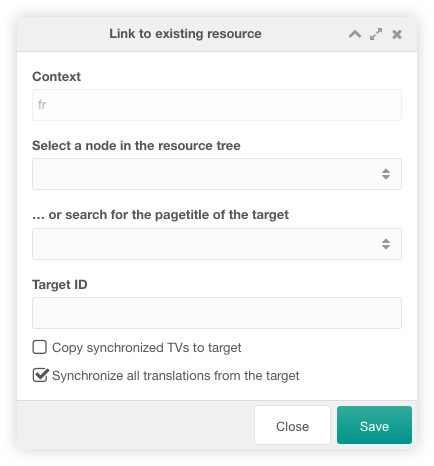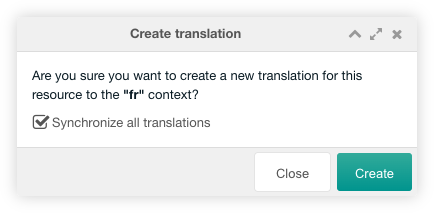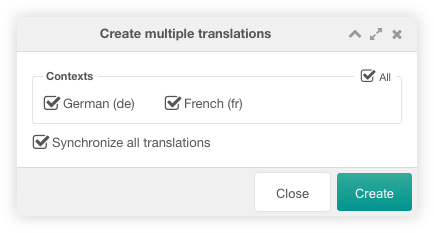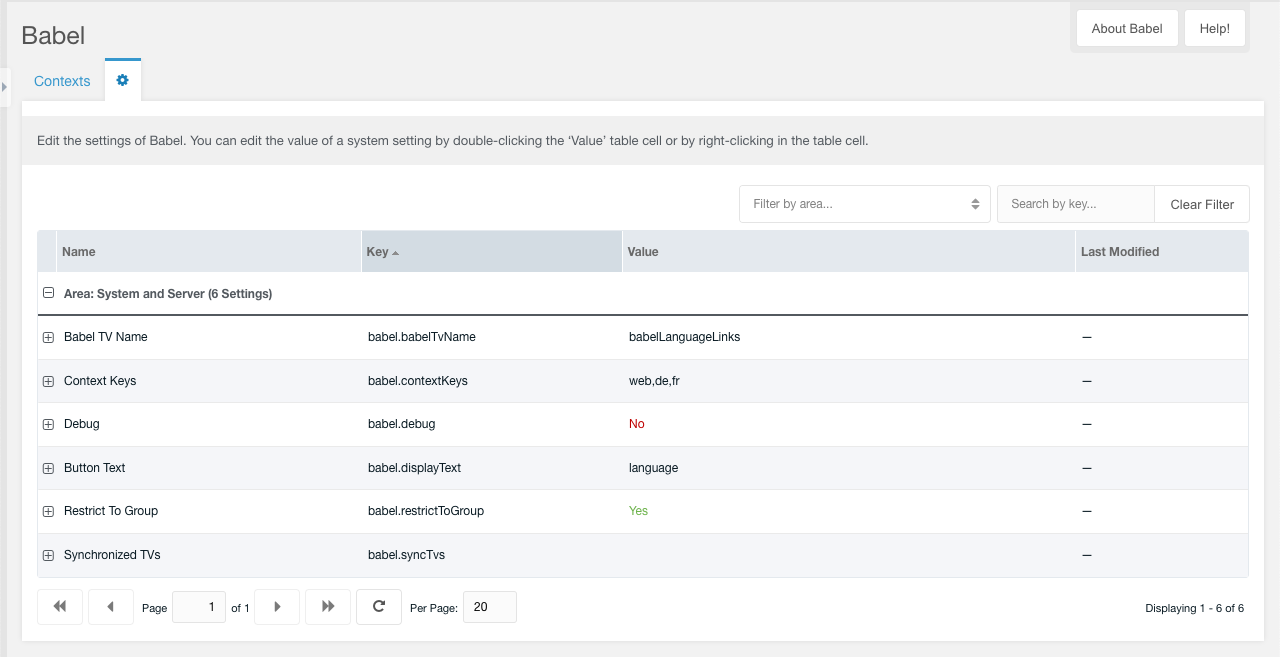Index
Babel contains a Babel Button, a custom manager page and two snippets.
Babel Button
The Babel Button is located on the top of a resource form. With this button you can create, link and update translated versions of the current resource in different contexts.
Hover the button and create, link, update and unlink the translated versions of the current resource. You can also unlink all translations from this resource and create multiple translations in selectable contexts with a menu entry.
If you create a link to an existing resource, the following window is displayed. You must select the linked resource via the page tree on the left, by searching for the page title or by entering the target ID directly.
If you enable 'Copy synchronized TVs to target', the synced template variables
(TVs) referenced in the system setting babel.syncTvs of all linked resources
are filled with the TV values of the current resource.
If you enable 'Synchronise all translations from the target', the language links of the target resource are synced between the linked resources. The current resource is also linked to the target resource and all linked resources. Otherwise, only the current resource is linked to all linked resources of the target resource and the link to the current resource is added to the links to the target resource.
If you create a translations of the current resource in a selected context, the following window is displayed.
If you enable 'Synchronise all translations', the language links of the current resource are synced between the linked resources. The created translation is linked to all linked resources. Otherwise, there is just a link created between the current resource and the new created translation.
If you create multiple translations of the current resource, the following window is displayed. You must select the contexts into which the current resource is not translated and for which you would like to create a translation.
If you enable 'Synchronise all translations', the language links of the current resource are synced between the linked resources. All created translations are linked to all linked resources. Otherwise, there is just a link created between the current resource and the new created translations.
Custom Manager Page
The custom manager page contains two tabs.
Contexts
In this tab you can manage the translated versions of a resource. The first
columns contain information of the source resource (ID, context and pagetitle)
and an All column to create multiple translations with a click on the
icon or remove all links to the source resource
with a click on the icon. For each translatable
context a grid column is available with two icons. The following icons are
available depending on the link state:
- to create a new resource to be linked,
- to link to this resource and its linked resources
- to update the linked resource
- to break the link
Settings
In this tab you can manage the system settings of Babel. The Tab is only shown for users that have the babel_settings or settings permission.
Snippets
Currently, there are two snippets available for Babel:
BabelLinks
BabelLinks is a snippet that displays links to other languages (contexts) in the frontend. It uses the following snippet properties:
| Property | Description | Default |
|---|---|---|
| activeCls | CSS class for the active language link. | active |
| ignoreSiteStatus | Flag whether to ignore the site_status (when the site is offline) | 0 (No) |
| includeUnlinked | Flag whether to show unlinked context. | 0 (No) |
| resourceId | ID of resource of which links to translations should be displayed. | Current resource ID |
| restrictToGroup | Restrict the contexts in the snippet output to the group of the current context. | System setting babel.restrictToGroup |
| showCurrent | Flag whether to show a link to a translation of the current language. | 0 (No) |
| showUnpublished | Flag whether to show unpublished translations. | 0 (No) |
| toArray | Flag whether to dump the output as an array instead. | 0 (No) |
| toPlaceholder | Flag whether to dump the output into the given placeholder's name. | - |
| tpl | Chunk to display a language link. | tplBabellink |
| wrapperTpl | Chunk to wrap all language links. The placeholder for all links is [[+babelLinks]]. | - |
You can use the following placeholders in the tpl chunk:
| Placeholder | Description |
|---|---|
| active | If link points to a resource of the current active language (context) this placeholder is set to the active CSS class name specified by the activeCls property. Otherwise this placeholder is empty. |
| contextKey | Context key of the translated resource. |
| contextName | Context name of the translated resource |
| cultureKey | Culture key of the translated resource (e.g en, de, fr oder es). You may use the babel lexicon to display the language's name: [[%babel.language_[[+cultureKey]]? &topic=`languages` &namespace=`babel`]] |
| id | ID of tranlated resource. If no translation is available this placeholder is empty ('') |
| language | Language description in the IANA language subtag registry |
| url | Url to linked translation (or site_url of specific language if there is no translated resource available). |
BabelTranslation
The BabelTranslation snippets returns the ID of a translated resource in a given context. It uses the following snippet properties:
| Property | Description | Default |
|---|---|---|
| contextKey | Key of context in which translated resource should be determined. | - |
| cultureKey | Key of culture in which translated resource should be determined. Used only in case contextKey was not specified. If both omitted the snippet the currently set cultureKey. | - |
| resourceId | ID of resource of which a translated resource should be determined. | Current resource ID |
| showUnpublished | Flag whether to show unpublished translations. | 0 (No) |
| toPlaceholder | Flag whether to dump the output into the given placeholder's name. | - |
System Settings
Babel uses the following system settings in the namespace babel:
| Key | Name | Description | Default |
|---|---|---|---|
| babel.babelTvName | Babel TV Name | Name of template variable (TV) in which Babel will store the links between multilingual resources. This TV will be maintained by Babel. | babelLanguageLinks |
| babel.contextKeys | Context Keys | Comma separated list of context keys which should be used to link multilingual resources. | - |
| babel.debug | Debug | Log debug information in the MODX error log. | No |
| babel.displayText | Button Text | Text shown in the Babel button for each context. You can use the following values: 'language', 'context' or 'combination' | language |
| babel.restrictToGroup | Restrict To Group | Restrict the contexts in the Babel button to the group of the current context. | Yes |
| babel.syncTvs | Synchronized TVs | Comma separated list of template variables (TVs) IDs to be synchronised by Babel. | - |
The button text in the Babel button can use the following values:
- language: the contexts are listed with the context language set in the cultureKey context setting.
- context: the contexts are listed with the context name.
- combination: the contexts are listed with the context name and the context language set in the cultureKey context setting.
Permissions
Babel has the following permissions for manager users:
| Permission | Description |
|---|---|
| babel_settings | Allow a user to manage the Babel system settings the Babel custom manager page. |
The permission check is not executed for sudo users.
Events
Babel invokes the following events which can be used in plugins:
OnBabelDuplicate
This event is invoked on duplicating the resource in a new language context. It uses the following parameters:
| Parameter | Description |
|---|---|
| context_key | The context key of the duplicated resource. |
| original_id | The ID of the original resource. |
| original_resource | The object of the original resource. |
| duplicate_id | The ID of the duplicated resource. |
| duplicate_resource | The object of the duplicated resource. |
OnBabelLink
This event is invoked on link the resource with a target resource. It uses the following parameters:
| Parameter | Description |
|---|---|
| context_key | The context key of the linked resource. |
| original_id | The ID of the original resource. |
| original_resource | The object of the original resource. |
| target_id | The ID of the linked resource. |
| target_resource | The object of the linked resource. |
OnBabelUnlink
This event is invoked on unlink the resource from a target resource. It uses the following parameters:
| Parameter | Description |
|---|---|
| context_key | The context key of the unlinked resource. |
| original_id | The ID of the original resource. |
| original_resource | The object of the original resource. |
| target_id | The ID of the unlinked resource. |
| target_resource | The object of the unlinked resource. |
OnBabelTVSynced
This event is invoked when TVs are synced and changed. It uses the following parameters:
| Parameter | Description |
|---|---|
| tv_changes | An array of the changes in the synced TVs. Each array element contains the values tv_id, tv_value and target_id. |
| resource_id | The ID of the resource the changes are synced from. |






